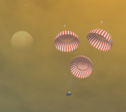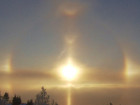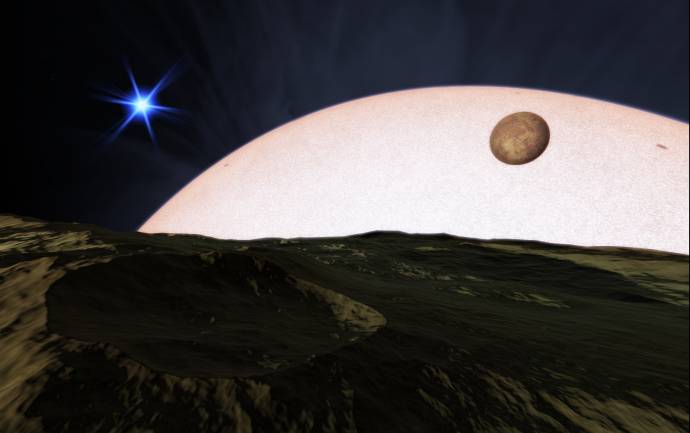|
Space anomalies
|
|
| HarbingerDawn | Date: Monday, 14.01.2013, 09:40 | Message # 76 |
 Cosmic Curator
Group: Administrators
 United States
United States
Messages: 8717
Status: Offline
| Quote (Jabberwockxeno6109) If I did, i assure you it was accidental.
It doesn't matter what you chose the camera to follow though, as you can clearly see the planet's orbital path around the stars and it moving along that path, while the star barycenter follows no path at all.
All forum users, please read this!
My SE mods and addons
Phenom II X6 1090T 3.2 GHz, 16 GB DDR3 RAM, GTX 970 3584 MB VRAM
|
| |
| |
| smjjames | Date: Monday, 14.01.2013, 14:47 | Message # 77 |
|
World Builder
Group: Users
 United States
United States
Messages: 913
Status: Offline
| Quote (LiveLife42) This planet has an extremely elliptical orbit and it has life.
Going from a frigid 76.138 K(-197.012 C)(-322.6216 F) to a comforting 280.58 K(7.43 C)(45.374 F)
Extremophile bacteria analogues, maybe methane based liquid? Hard to imagine life even evolving there in the first place, let alone complex multicellular life evolving (well okay, maybe if it were around a long lived star like a red dwarf)
The orbit itself is an anomaly though because it's not gravitationally stable. what with crossing so many orbits.

|
| |
| |
| NovaSilisko | Date: Tuesday, 15.01.2013, 07:13 | Message # 78 |
 Explorer
Group: SE team
 United States
United States
Messages: 288
Status: Offline
| I've found... something.
http://www.youtube.com/watch?v=Dk1KHf8tqMA
Edit: this is the strangest thing I have ever found...



Edited by NovaSilisko - Tuesday, 15.01.2013, 08:02 |
| |
| |
| midtskogen | Date: Tuesday, 15.01.2013, 08:42 | Message # 79 |
 Star Engineer
Group: Users
 Norway
Norway
Messages: 1674
Status: Offline
| Quote (smjjames) I've found... something.
Wow! Nice find. The system doesn't look very stable. Here's another impossible view, a planet and moon within the star's corona:

The star was flickering behind and in front of the planet and moon.
NIL DIFFICILE VOLENTI

Edited by midtskogen - Tuesday, 15.01.2013, 09:52 |
| |
| |
| SpaceEngineer | Date: Tuesday, 15.01.2013, 12:18 | Message # 80 |
 Author of Space Engine
Group: Administrators
 Russian Federation
Russian Federation
Messages: 4800
Status: Offline
|
Did you have a location? Looks like double description of the catalog star.
Quote (midtskogen) Here's another impossible view, a planet and moon within the star's corona:
This is not impossible.

|
| |
| |
| HarbingerDawn | Date: Tuesday, 15.01.2013, 13:26 | Message # 81 |
 Cosmic Curator
Group: Administrators
 United States
United States
Messages: 8717
Status: Offline
| Quote (SpaceEngineer) Looks like double description of the catalog star.
As the video shows, it is a procedural system in a procedural galaxy.
All forum users, please read this!
My SE mods and addons
Phenom II X6 1090T 3.2 GHz, 16 GB DDR3 RAM, GTX 970 3584 MB VRAM
|
| |
| |
| midtskogen | Date: Tuesday, 15.01.2013, 13:45 | Message # 82 |
 Star Engineer
Group: Users
 Norway
Norway
Messages: 1674
Status: Offline
| Quote (SpaceEngineer)
Quote (midtskogen)
Here's another impossible view, a planet and moon within the star's corona:
This is not impossible.
I see at least a couple of problems: Temperature and tidal forces. It's hard to imagine a solid surface in that position. And in this case the planet-moon system is at a height above the surface of the star that is less than 1/5 of the star's radius (that places it within the inner corona). And that also has to be inside the star's roche limit for any known planet/moon density.
The systems can be found at RS 0-9-14448641-189-0-0-0-1.
NIL DIFFICILE VOLENTI

Edited by midtskogen - Tuesday, 15.01.2013, 13:46 |
| |
| |
| apenpaap | Date: Tuesday, 15.01.2013, 13:59 | Message # 83 |
 World Builder
Group: Users
 Antarctica
Antarctica
Messages: 1063
Status: Offline
| Wow, that is a bizarre system; it's pretty much two binary systems placed within each other, but not actually considered the same system by the program
I occasionally stream at http://www.twitch.tv/magistermystax. Sometimes SE, sometimes other games.
|
| |
| |
| smjjames | Date: Tuesday, 15.01.2013, 17:00 | Message # 84 |
|
World Builder
Group: Users
 United States
United States
Messages: 913
Status: Offline
| If it weren't for the fact that it's random, I'd have said it was a duplicated catalog object, but the galaxy itself seems fine (although it won't show the label in universe view) and it seems to have been only that specific star.

|
| |
| |
| Watsisname | Date: Tuesday, 15.01.2013, 17:12 | Message # 85 |
 Galaxy Architect
Group: Global Moderators
 United States
United States
Messages: 2613
Status: Offline
| Quote (midtskogen) I see at least a couple of problems: Temperature and tidal forces. It's hard to imagine a solid surface in that position.
Space Engine computes the equilibrium surface temperature for any object based on the solar flux at its location, so you could check that. At that distance a rocky planet would indeed be molten or even have a vaporized rock atmosphere. WASP-12b and KIC 12557548-b are real examples of such planets. Space Engine does not yet support molten/vaporized planets though; it just gives us a solid surface regardless of how high the surface temperature is.
Quote And that also has to be inside the star's roche limit for any known planet/moon density.
Has to be? How do you know? Have you checked?  I'm not a fan of assertions on how the universe operates that are unsupported by data or physics. So how about we find out for sure? I'm not a fan of assertions on how the universe operates that are unsupported by data or physics. So how about we find out for sure?
Neglecting complicating factors such as the fluid deformation of the planet, then the Roche limit is approximately 2.44 times the radius of the star times the cube root of the ratio of the star density over planet density. For a rocky planet like Earth (density ~5.5g*cm-3) orbiting a sun-like star (density ~1.4g*cm-3), the Roche limit is about a million kilometers, or ~1.4 times the sun's radius. If you consider a less dense star, like an aging giant, then the Roche limit is well within the star's radius so you could easily have terrestrial planets very close to the star without them being torn apart by tidal forces, at least for as long as the heat doesn't evaporate them completely. 

Edited by Watsisname - Tuesday, 15.01.2013, 17:13 |
| |
| |
| NovaSilisko | Date: Tuesday, 15.01.2013, 20:01 | Message # 86 |
 Explorer
Group: SE team
 United States
United States
Messages: 288
Status: Offline
| Quote (SpaceEngineer) Did you have a location? Looks like double description of the catalog star.
No, it wasn't a catalog star, it was procedural.
Here's the place code:
Code
Place "what"
{
Body "RS 0-9-14448641-189-0-0-0-1 1"
Parent ""
Pos (0.000374125004218776, 0.0004294820672383628, -0.001381646329938651)
Rot (-0.3453713429261654, 0.6945627826493165, -0.3558805780981313, -0.521200720045891)
Date "5985.05.21 04:26:07.16"
Vel 1.6301556e-005
Mode 1
} |
| |
| |
| midtskogen | Date: Tuesday, 15.01.2013, 20:30 | Message # 87 |
 Star Engineer
Group: Users
 Norway
Norway
Messages: 1674
Status: Offline
| Watsisname, Wikipedia has a pretty extensive article on the roche limit. I can't know for sure that it's accurate, but it gives some examples for the sun and different satellites. I checked the article before I posted, and since a 1/5 radius is well within the figures given in the article, I thought it safe to write "has to be". 
On the other hand, if the planet is solid lead and the star exceptionally fluffy, I might be wrong.
NIL DIFFICILE VOLENTI

|
| |
| |
| Watsisname | Date: Tuesday, 15.01.2013, 21:36 | Message # 88 |
 Galaxy Architect
Group: Global Moderators
 United States
United States
Messages: 2613
Status: Offline
| Are you measuring that from the star center or the star surface? The figures you see on wikipedia are from the center, so R < 1 means it is within the primary. Indeed, wikipedia claims the rigid limit for the Earth/Sun case is 0.8, or within the Sun. (I think that's wrong though, it should be ~1.4Rsun, as shown above).
I also question that article's claim that if the secondary is more than twice as dense as the primary, then the Roche limit is inside the primary for the rigid case. That does not seem correct. If you take d = RM and solve for the (inverted) density ratio, you get ~15, not 2. This is still very easy to achieve for solid planets orbiting giant stars, however.

|
| |
| |
| midtskogen | Date: Tuesday, 15.01.2013, 22:32 | Message # 89 |
 Star Engineer
Group: Users
 Norway
Norway
Messages: 1674
Status: Offline
| 1/5 from the star surface. A limit < 1 meaning inside the primary seems surprising considering that Saturn is less dense than ice, yet has rings extending more than 1 R from the surface. That would hardly give much support the hypothesis that the rings were the result of a moon that came within the limit. Then a moon denser than 1374 kg/m³ (most moons are) would collide with Saturn before breaking up according to the article. Anyway, something almost scratching the surface of a main sequence star would be molten, which will push the limit out of the primary even for very dense objects if the Wikipedia article is accurate.
NIL DIFFICILE VOLENTI

|
| |
| |
| Watsisname | Date: Tuesday, 15.01.2013, 23:36 | Message # 90 |
 Galaxy Architect
Group: Global Moderators
 United States
United States
Messages: 2613
Status: Offline
| Saturn is less dense than ice? Really? What exactly is the density of ice? "Icy" bodies in our solar system can have a variety of densities depending on their precise characteristics (how much rock is in them, have they undergone differentiation, etc?). Consider that Europa is ~3g/cm^3, while Enceladus is ~1.6. Janus is 0.63 (less than Saturn!). Comets can be around 0.5!
And take a closer look at that formula again. If we assume Saturn and the ring material are of the same density, then the equation reduces to d = 2.44 RSaturn. The Roche limit does not become less than the primary radius unless the ratio of densities is greater than ~15.
And yes, the origin of Saturn's rings are generally thought to be from a comet or icy moon, though there is still a fair amount of debate on this, particularly with respect to their age. This is a good article on the subject if you're interested in learning more.

|
| |
| |